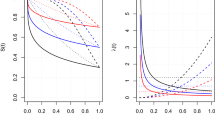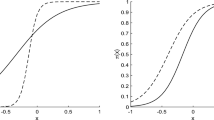Abstract
In this paper, optimal population designs for linear regression model with a random intercept for longitudinal data are considered. The design space is assumed to be a set of equally spaced time points. Taking the sampling scheme for each subject as a multidimensional point in the space of admissible sampling sequence, we determine the optimal number and allocation of sampling times in order to estimate the fixed effects model as accurately as possible. To make comparisons between different designs in a meaningful manner, we take experimental costs into account when defining the D-optimal design criterion function. We take a Bayesian method to overcome the uncertainty of the parameters in the design criterion to derive Bayesian optimal population designs. For complicated cases, we propose a hybrid algorithm to find optimal designs. Meanwhile, we apply the Equivalence Theorem to check the global optimality of these designs.




Similar content being viewed by others
References
Abebe HT, Tan FES, Breukelen GJPV, Berger MPF (2014a) Bayesian \(D\)-optimal designs for the two parameter logistic mixed effects model. Comput Stat Data Anal 71:1066–1076
Abebe HT, Tan FES, Breukelen GJPV, Berger MPF (2014b) Robustness of Bayesian \(D\)-optimal design for the logistic mixed model against misspecification of autocorrelation. Wiley Ser Comput Stat 29:1667–1690
Abt M, Liski EP, Mandal NK, Sinha BK (1997) Optimal designs in growth curve models: part I. Correlated model for linear growth: optimal designs for slope parameter estimation and growth prediction. J Stat Plan Inference 64:141–150
Abt M, Gaffke N, Liski EP, Sinha BK (1998) Optimal designs in growth curve models-II. Correlated model for quadratic growth: optimal designs for parameter estimation and growth prediction. J Stat Plan Inference 67:287–296
Atkins JE, Cheng CS (1999) Optimal regression designs in the presence of random block effects. J Stat Plan Inference 77:321–335
Atkinson AC, Donev AN, Tobias RD (2007) Optimum experimental designs, with SAS. Oxford University Press Inc., New York
Berger MPF, Tan FES (2004) Robust designs for linear mixed effects models. J R Stat Soc Ser C 53:569–581
Chen RB, Chang SP, Wang W, Tung HC, Wong WK (2014a) Minimax optimal designs via particle swarm optimization methods. Stat Comput 25(5):975–988
Chen RB, Hsu YW, Hung Y, Wang W (2014b) Discrete particle swarm optimization for constructing uniform design on irregular regions. Comput Stat Data Anal 72:282–297
Cheng CS (1995) Optimal regression designs under random block-effects models. Stat Sin 5:485–497
Chernoff H (1953) Locally optimal designs for estimating parameters. Ann Math Stat 24:586–602
Debusho LK (2004) Optimal designs for linear mixed models. PhD thesis, South Africa, University of KwaZulu-Natal
Debusho LK, Haines LM (2008) \(V\)- and \(D\)-optimal population designs for the simple linear regression model with a random intercept term. J Stat Plan Inference 138:1116–1130
Debusho LK, Haines LM (2011) \(D\)- and \(V\)-optimal population designs for the quadratic regression model with a radom intercept term. J Stat Plan Inference 141:889–898
Duchateau L, Janssen P, Rowlands GJ (1998) Linear mixed models. An introduction with applications in veterinary research. International Livestock Research Institute, Nairobi
Dette H, Pepelyshev A, Holland-letz T (2010) Optimal designs for random effect models with correlated errors with applications in population pharmacokinetics. Ann Appl Stat 3:1430–1450
Eberhart RC, Kennedy J (1995) A new optimizer using particle swarm theory. In: Proceedings of the sixth international symposium on micro machine and human science(Nagoya, Japan). IEEE Service Center, Piscataway, pp 39–43
Fedorov V, Leonov S (2013) Optimal design for nonlinear response models. CRC Press, Boca Raton
Gagnon R, Leonov S (2005) Optimal population designs for PK models with serial sampling. J Biopharm Stat 15:143–163
Gilks WR, Wild P (1992) Adaptive rejection sampling for Gibbs sampling. Appl Stat 41:337–348
Goos P (2002) The optimal design of blocked and split-plot experiments. Springer, NewYork
Gueorguieva I, Aarons L, Ogungbenro K, Jorga KM, Rodgers T, Rowland M (2006) Optimal design for multivariate response pharmacokinetic models. J Pharmacokinet Pharmacodyn 33:97–124
Kennedy J, Eberhart RC (1997) A discrete binary version of the particle swarm algorithm. In: IEEE international conference on in systems, man, and cybernetics, vol 5. IEEE, pp 4104–4108
Khuri AI (1992) Response surface models with random block effects. Technometrics 34:26–37
Magnus J, Neudecker H (1999) Matrix differential calculus with applications in statistics and econometrics. Wiley, New York
Mentré F, Mallet A, Baccar D (1997) Optimal design in random-effects regression models. Biometrika 84:429–442
Niaparast M (2009) On optimal design for a Poisson regression model with random intercept. Stat Probab Lett 79:741–747
Ouwens MJNM, Tan FES, Berger MPF (2002) Maximin D-optimal designs for longitudinal mixed effects models. Biometrics 58:735–741
Ouwens MJNM, Tan FES, Berger MPF (2006) A maximin criterion for the logistic random intercept model with covariates. J Stat Plan Inference 136:962–981
Poli R, Kennedy J, Blackwell T (2007) Particle swarm optimization: an overview. Swarm Intell 1:33–57
Prus M, Schwabe R (2016) Optimal designs for the prediction of individual parameters in hierarchical models. J R Stat Soc Ser B Stat Methodol 78:175–191
Retout S, Comets E, Smason A, mentré F (2007) Design in nonlinear mixed effects models: optimization using the Fedorov–Wynn algorithm and and power of the Wald test for binary covariates. Stat Med 26:5162–5179
Ryan EG, Drovandi CC, Pettitt AN (2015) Simulation-based fully Bayesian experimental design for mixed effects models. Comput Stat Data Anal 92:26–39
Snijders TAB, Bosker RJ (1999) Multilevel analysis. SAGE, London
Tan FES, Berger MPF (1999) Optimal allocation of time points for the random effects model. Commun Stat Simul Comput 28:517–540
Tekle FB, Tan FES, Berger MPF (2008) \(D\)-optimal cohort designs for linear mixed-effects models. Stat Med 27:2586–2600
Tommasi C, Rodríguez-Díaz JM, Santos-Martí MT (2014) Integral approximations for computing optimum designs in random-effects logistic regression models. Comput Stat Data Anal 71:1208–1220
Verbeke G, Molenberghs G (2000) Linear mixed models for longitudinal data. Springer, New York
Waite TW, Woods DC (2015) Designs for generalized linear models with random block effects via information matrix approximations. Biometrika 102(3):677–693
Wong WK, Chen RB, Huang CC, Wang W (2015) A modified particle swarm optimization technique for finding optimal designs for mixture models. PLoS ONE. https://doi.org/10.1371/journal.pone.0124720
Acknowledgements
This work was partially supported by NSFC Grant (11301332, 11471216), China.
Author information
Authors and Affiliations
Corresponding author
Rights and permissions
About this article
Cite this article
Zhou, XD., Wang, YJ. & Yue, RX. Robust population designs for longitudinal linear regression model with a random intercept. Comput Stat 33, 903–931 (2018). https://doi.org/10.1007/s00180-017-0767-6
Received:
Accepted:
Published:
Issue Date:
DOI: https://doi.org/10.1007/s00180-017-0767-6




